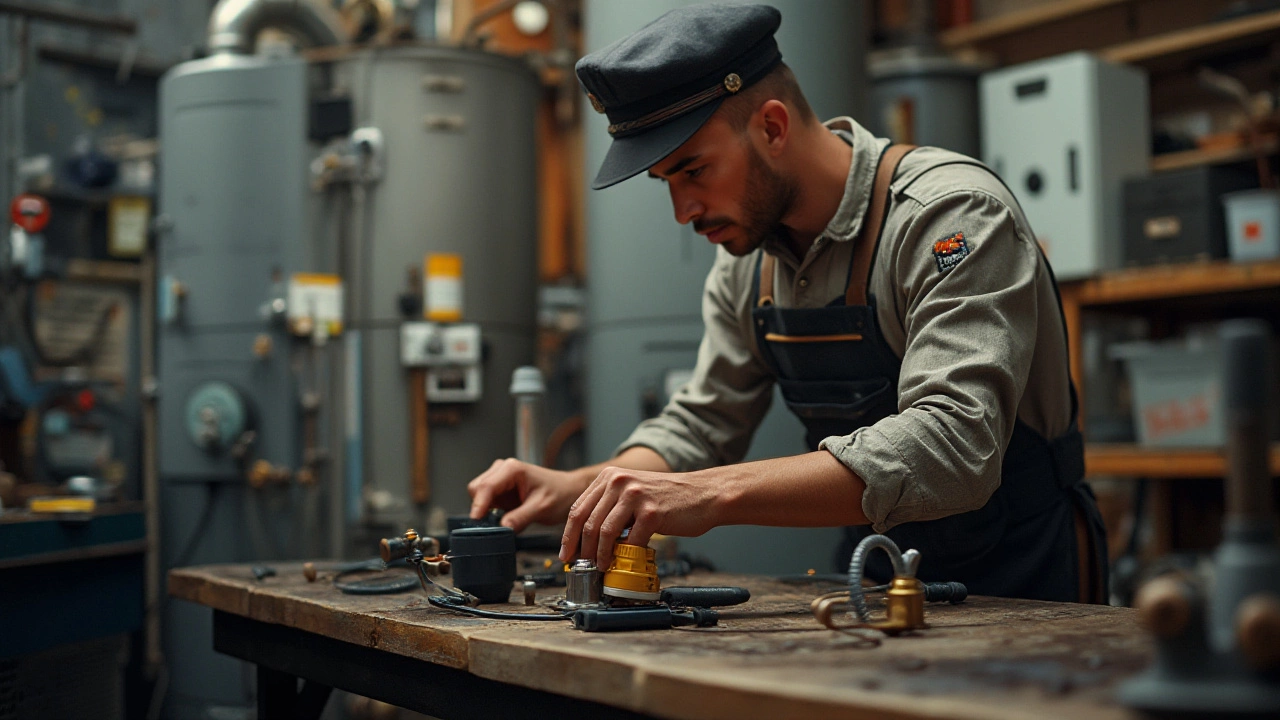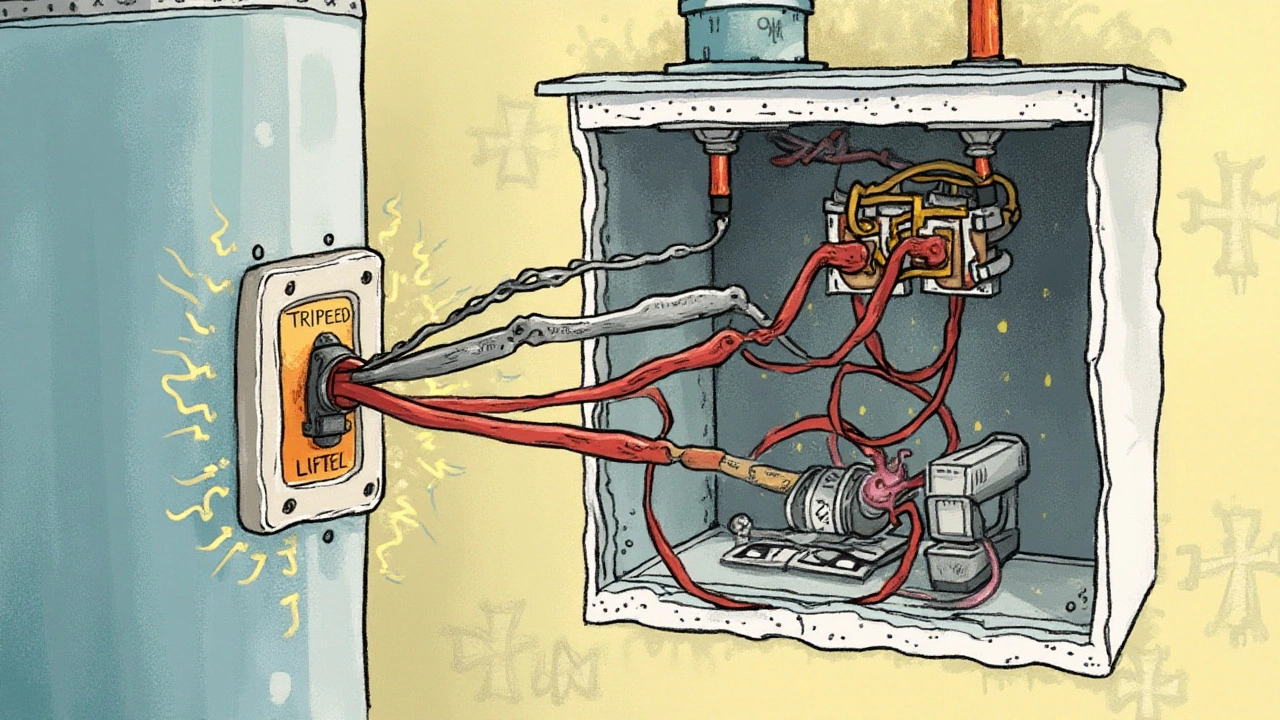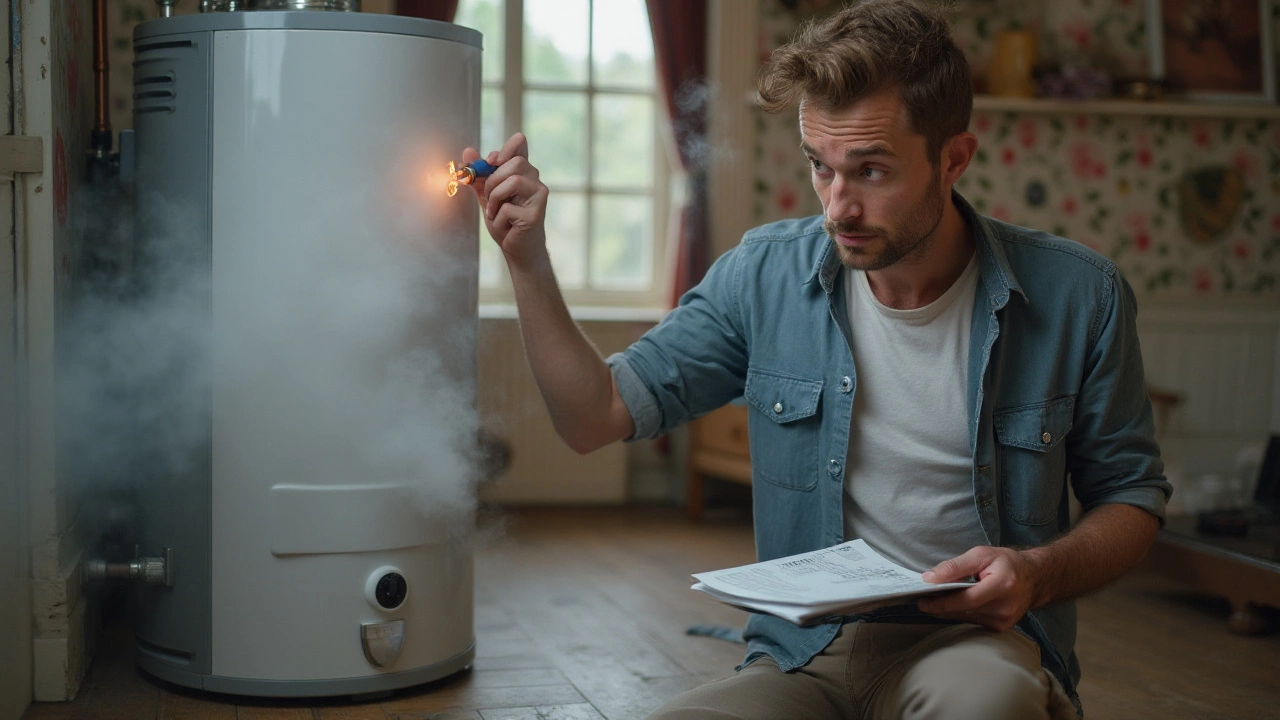Have you ever experienced the frustration of a luke-warm shower just when you need it most? If your hot water heater's been causing perplexing issues, like tripping its reset button too often, you're not alone. It's a common annoyance for many homeowners, but rarely understood.
This elusive button is more than a mere inconvenience – it's an essential safety feature designed to prevent your water heater from overheating and causing damage. But what exactly causes it to trip, and how can you fix it? We'll explore some of the most common reasons and offer practical tips on how to troubleshoot and maintain your heater.
Whether it's a thermostat going rogue or an electrical fault, we'll guide you through straightforward methods so you can enjoy hot water without a hitch. Let's dive into a world where your morning routines run smoother, with nothing but comfort at your fingertips.
- Understanding the Reset Button
- Common Causes of Tripping
- Safety Tips for Troubleshooting
- How to Reset a Hot Water Heater
- When to Call a Professional
- Preventive Maintenance Tips
Understanding the Reset Button
The humble reset button on your hot water heater often goes unnoticed – until it trips, leaving you with cold showers and a burning question of why it exists in the first place. The button is not just a quick-fix tool; it is a crucial safety component tailored to prevent your water heater from exceeding temperature limits that could potentially cause serious issues, even damage. Typically, this button is linked to a protective device known as the high-limit switch or an energy cut-off (ECO) switch in technical jargon. It is designed to cut power to the heating elements when the water temperature reaches unsafe levels, a situation which would otherwise pose risks of scalding or even cause damage to the heater itself.
When your water heater is operating normally, the thermostat regulates the water temperature, and there’s no need for the reset button to engage. But things aren't always so simple, right? Sometimes, when a thermostat fails or becomes faulty, it might allow the heating elements to work overtime. This causes the water to overheat, hence tripping the reset button. Keep in mind, this isn't just about protecting the appliance; it's primarily about keeping your home safe from potential fires or water heater failures that could lead to costly repairs.
Understanding the mechanics of the reset button is crucial. Imagine it as the sentry standing guard against overheating, the guardian ensuring the water heater functions within safe parameters. But why does it trip so often, and how can you tell it’s truly an issue? According to experts at the U.S. Department of Energy, consistent tripping could indicate an underlying problem that needs addressing, such as faulty wiring, a bad thermostat, or a failing heating element. These elements, while small components of the water heater system, play significant roles in its overall functionality.
As daunting as it might sound, tackling this aspect of your water heater repair doesn’t always require a professional. In fact, resetting the button is a straightforward process. It’s a simple act of pressing the button, usually red, located near the thermostat. This might provide a temporary fix until you can dive in deeper to diagnose the core issue. However, habitual resetting without inspection might mask underlying issues, risking further complications down the line.
Given the evolving nature of water heaters and home safety standards, staying informed about such features is not just beneficial but necessary. With the advent of more energy-efficient models and innovations, these buttons may evolve, but their essence remains the same. They stand for safety—a commitment from manufacturers to ensure their appliances not only function optimally but also safeguard users. If you're stepping into water heater maintenance or troubleshooting for the first time, don’t let it intimidate you. Rather, let it empower you as you unravel the secrets of this small but mighty button.
Common Causes of Tripping
When it comes to understanding why your hot water heater keeps tripping its reset button, it helps to be aware of the most common culprits. Often, these issues revolve around elements that regulate or measure heat. The role of the reset button is to cut power to the heater when temperatures rise too high, preventing damage and potential hazards. One prevalent cause is a malfunctioning thermostat. If your water heater's thermostat isn't accurately gauging water temperature, it might continuously heat the water until temperatures surpass safe limits, causing the reset button to engage.
In addition to thermostat problems, faulty heating elements can also lead to tripping issues. Over time, these components can corrode or break, causing them to draw more current than they should. This not only results in safety risks but also in increased energy bills. For instance, a faulty element might struggle to heat water effectively, leading to unnecessarily prolonged active heating periods, which can trigger the reset switch. An electrical short within the heating element can also cause similar problems, leading to the reset button being tripped.
Electrical issues aren’t confined to the water heater's components alone. Wiring problems, whether due to age, wear, or improper initial installation, can cause irregular power delivery. This irregularity occasionally leads to overheating or inconsistent water temperatures, and the protective mechanism of the reset button comes into play. A loose wire or short circuit in any of the heater's critical components can be detrimental not just to the heater itself but also to your household safety. According to an expert in thermodynamics from MIT, "an improperly grounded water heater is a ticking time bomb, waiting to discharge unpredictably."
Another factor to consider is sediment buildup. Many homes in New Zealand experience 'hard water,' which carries a significant quantity of dissolved minerals like calcium and magnesium. Over time, these minerals settle at the bottom of water heaters, forming a sediment layer. This layer acts as a barrier to effective heating, meaning your heater must work harder, longer. This increased activity can raise the water heater's temperature beyond safe thresholds, forcing the reset button to intervene.
It’s also worth checking the high limit switch. This device, part of the thermostat assembly, serves as a fail-safe in case the primary thermostat malfunctions. If the high limit switch is faulty, it might trip unnecessarily. You'll often find this switch on the water heater's upper panel – a small component with a tremendous responsibility. Failing to address these hot water heater issues promptly can lead to more frequent and irritating interruptions. Being proactive in identifying these causes not only ensures a more reliable hot water supply but also extends the lifespan of your unit.

Safety Tips for Troubleshooting
When it comes to addressing issues with your hot water heater, prioritizing safety during troubleshooting is crucial. This isn't just about preserving your appliance but ensuring your wellbeing. Before diving into solutions, it's imperative to be well-prepared and informed of the possible hazards. The first rule of thumb is to always cut off power supply to the heater by flipping the circuit breaker dedicated to your hot water heater. This simple yet often overlooked step can prevent electrical shocks that can occur when tampering with live wires. Additionally, ensure the water heating system is fully cooled before you inspect or work on it, as direct contact with overheated components can result in severe burns.
Consider the fact that a more common cause of a trip could be an electrical fault. Loose wire connections or damaged external cabling are frequently identified culprits. Once the power is off, conducting a visual inspection can help spot obvious hazards like frayed wires. Remember, even if wires appear secure, problems can be hidden beneath, so exercising caution is essential. In many cases, it's beneficial to have a multimeter, available at most hardware stores, to check for continuity in wires.
Another area of concern is the malfunctioning thermostat, which might cause the water to heat beyond the set temperature. Overheating isn't just uncomfortable; it can lead to pressure build-up in your tank, posing a significant danger. Therefore, it's wise to check the thermostat settings, typically found on the side of most water heaters. Ensure it's calibrated correctly—usually between 120-140 degrees Fahrenheit for optimal efficiency without overheating. If you aren't comfortable making these checks, remember it's always safer to contact a professional.
'Dealing with high-voltage appliances requires care and knowledge,' advises John Williams, a renowned home appliance expert. 'Understanding and respecting the power and function of these devices is the first step to safe troubleshooting.'The importance of worn-out runway checks cannot be emphasized enough. Examine the rods and heating elements for any signs of corrosion or damage. The presence of limescale builds up, often signified by a white, powdery substance on rods, can decrease efficiency and heighten the risk of complications leading to thermal cutoffs. For homeowners in hard water areas, the need for vigilance, frequent inspections, and bi-annual flushing is recommended to keep the systems in check.
If replacing or mending specific components, using quality parts is non-negotiable. Unsanctioned parts, which might initially seem like a bargain, can introduce unforeseen issues and void warranties. Keeping a user's manual at hand during repair is practical, offering guidance through component-specific troubleshooting procedures.
Lastly, it's crucial to know when to stop and call an expert. If you've exhausted these approaches and the reset button still trips regularly, professional advice ensures the problem is comprehensively diagnosed and properly fixed, minimizing safety risks. With these guidelines, you can handle minor issues confidently, always placing safety at the forefront.
How to Reset a Hot Water Heater
When the hot water heater hits the reset button, it can feel like a dark cloud over your day, particularly when you're eagerly anticipating a warm, inviting shower. Resetting the heater is usually a straightforward process if you know the steps, but it's important to understand why the mishap occurred in the first place. The reset button is typically located on the heater's thermostat and is often colored red for easy identification. This little button is your immediate solution to resuming hot water flow, but make sure to proceed with caution, acknowledging the protective mechanism it represents.
First, safety comes foremost. Before you begin any reset process, ensure the power source is turned off. You can do this by switching off the breaker for the water heater at your home's main electrical panel. The potential risks of electric shock are severe, and this step ensures you're working in a secure environment. With the power safely disconnected, access the thermostat panel—most likely situated on the side of the tank—and remove the cover with a screwdriver to unveil the reset button.
Once inside, inspect the thermostat and the surrounding area for signs of trouble such as burned parts or corrosion. If anything appears unusual, you might be dealing with a more serious issue requiring professional attention. Assuming everything looks intact, pressing the reset button will typically click into place to signal that it's been reset. After resetting, reattach all panels securely to prevent any moisture entry, which could complicate your heater's operations and safety.
After the panel is reassembled, restore power to the unit by flipping the breaker back on. Wait for about 12-24 hours to allow the water heater to heat a new supply of water. If the reset button trips immediately or within a short span repeatedly, this is a red flag pointing to inherent electrical component problems such as a faulty thermostat or overheating issues. It's wise at this juncture to confide in professionals who possess the essential expertise to dissect and resolve such complexities.
"One of the biggest misconceptions about water heaters," says plumbing expert Jack Sullivan, "is that constant reset button issues are normal. They’re not. Consistent tripping means it’s time to diagnose deeper system flaws."
If you're dealing with ongoing troubles, another handy tip is to clean sediment buildup, which may hinder the heating process. Sediment typically gathers at the tank's bottom, and regular flushing can significantly enhance your heater’s efficiency and increase its lifespan. Not only does routine cleaning help in using energy economically, but it also prevents hard water from causing long-term damage.
Here's a succinct guide on how you can conduct a reset: Start by ensuring safety mainly by turning off the unit’s power. Remove the thermostat panel; press the reset button; return the cover securely; turn the power back on; and then patiently wait until the water heats up. This approach assures a more confident handling of any hot water heater hiccups, restoring warmth to your home seamlessly.

When to Call a Professional
Let's face it: dealing with a hot water heater can be as confusing as deciphering an ancient text. Sure, some fixes are a breeze and can be DIYed if you're feeling adventurous, but it's important to recognize when it's time to dial in the pros. For starters, if you've tried to pinpoint the trouble and nothing changes, it might be a deeper issue that requires an expert's touch. Don't get bogged down in complexities that might cause more harm than good. An experienced professional will have the right tools and knowledge to tackle the job efficiently.
Signs of electrical issues, such as persistent tripping of the reset button, could indicate deeper wiring troubles needing a deeper look. If there’s any suspicion, let a licensed electrician step in. Dealing with electrical elements isn't a place to skimp on expertise. Similarly, if you've never ventured into water heater repair before, and the thought of dismantling things intimidates you, it's probably best not to test your limits. A professional can quickly assess whether thermostats or heating elements need replacing.
For those rusted and leaky tanks causing you a headache, that’s a clear signal for professional intervention. Continued leakages can lead to hefty damages if ignored or improperly addressed. Say goodbye to minor patch-ups and hello to lasting solutions brought by those who know their craft. It's usually more cost-effective to handle it right the first time than dealing with potential water damage cleanup later on.
“Hiring a professional isn’t admitting defeat; it’s ensuring the long-term functionality and safety of your home’s hot water heater system.” – Alex Kaufman, Plumbing Expert
Professional Assessment and Maintenance
The value of professional maintenance shouldn’t be underrated. Routine check-ups can potentially dodge the more significant issues before they rear their ugly heads. A pro can spot wear and tear not obvious to the novice eye, ensuring your heater remains up to the task as seasons change. Professionals also have access to the latest information and tools for efficient repair and are familiar with a wide variety of heater models.
If you find yourself frequently resetting the system or encountering unusual noises emanating from the unit, that’s a glaring red flag. At this juncture, don't risk a breakdown at the worst possible time. While DIY troubleshooting tips are plentiful and often helpful, there’s art and precision to professional plumbing services that can't be replicated. In the end, a professional touch can ensure peace of mind knowing your hot showers are safeguarded.
Preventive Maintenance Tips
Engaging in regular maintenance for your hot water heater can often be the secret to avoiding unexpected cold showers and ensuring a long-lasting, efficient appliance. It might seem mundane, but attending to these simple tasks can save you time and money in the long run. One of the most critical steps in maintaining your water heater is to routinely check and flush the tank to eliminate sediment buildup. Over time, mineral deposits can settle at the bottom of the tank, affecting the heater's efficiency and potentially leading to malfunctions. By draining a few gallons of water from the tank every few months, you can prevent these unwanted sediments from reducing your appliance's performance.
Another aspect of maintenance involves checking the temperature setting on the thermostat. To ensure safety and efficiency, it's recommended to set your heater's thermostat to around 120 degrees Fahrenheit. This temperature is efficient for most households, allowing the water heater to perform without using excessive energy or causing unnecessary wear and tear. A lower setting not only conserves energy but also reduces the risk of scalding and prolongs the life of the heater. If you're unsure about how to adjust the settings, your user manual can be a handy guide.
According to the U.S. Department of Energy, "lowering your water heater temperature by 10 degrees can save you between 3-5% annually on energy costs."
Insulation is another smart preventive measure for maintaining your hot water heater's efficiency. By insulating the pipes and the tank itself, you help minimize heat loss, which can reduce the energy the heater needs to maintain the desired water temperature. Special insulating blankets can be found at most home improvement stores and are simple to apply. This is particularly helpful if your heater is located in a drafty area of your home, where the ambient temperature can have a substantial impact on the cost to heat water.
Regular inspections of the anode rod should also be part of your hot water heater’s preventive maintenance routine. This component is essential in preventing tank corrosion and typically needs to be changed every few years. If the rod looks pitted or heavily corroded, it's time for a replacement. Checking it annually can help you stay ahead of potential rust issues, which can lead to leaks or even tank failure if left unchecked. Such proactive care ensures your hot water heater remains functional and reliable for years.
Finally, consider scheduling a professional inspection. While DIY upkeep is effective, having a certified technician examine your hot water heater every couple of years can catch more subtle issues. An expert can perform more detailed maintenance tasks and provide insights into the heater's condition, offering peace of mind. They can also spot potential problems before they become bigger issues, which can save you from unplanned repairs or full replacement costs.
By following these preventive maintenance tips, not only can you extend the life of your hot water heater, but you can ensure it runs at optimal efficiency. Remember, a little attention now can prevent serious headaches down the road, keeping your showers and budgets comfortably warm.


